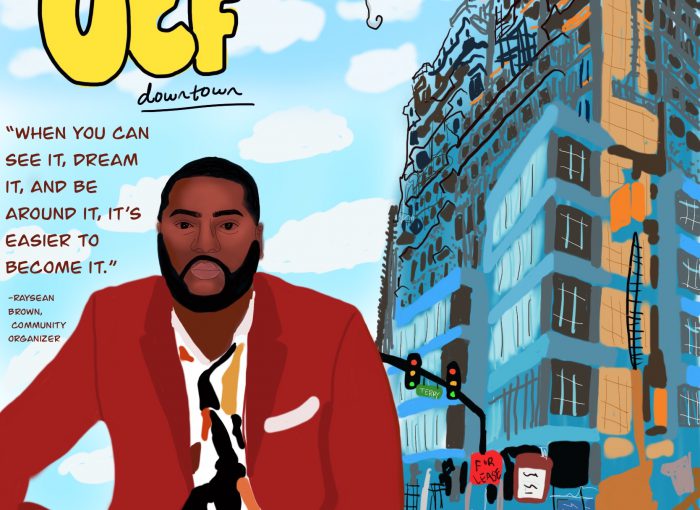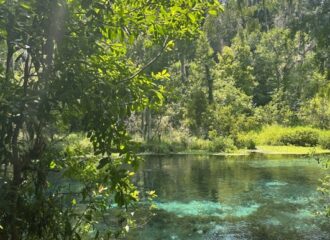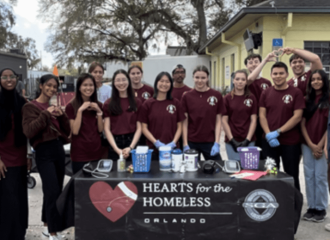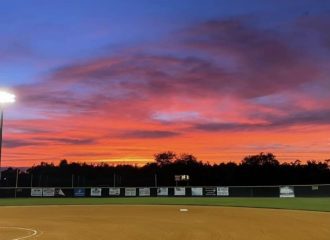Original art by Maliha Kareem
By Maliha Kareem
The University of Central Florida (UCF) opened the new downtown campus in August 2019, where over 7,000 students now attend. This space is in the heart of downtown Orlando, enjoying a view of the cityscape, yet also directly neighboring Parramore: Orlando’s historic black community and one of the lowest income areas of the city. As Parramore residents face the ongoing changes UCF downtown development will bring, we as students and community members must be aware of the development’s impacts and how we can be allies to the Parramore community.
Community organizer RaySean Brown gave a tour around Parramore to my UCF service-learning course, Writing for Social Change. Brown comes from a lineage of Parramore residents, and generations of his family lived and rented there for decades. This sort of relationship is typical for the small neighborhood, which is made up of 73% renters, which is high compared to the entire greater Orlando metro area, comprised of 40% renters.
Upon touring the neighborhood with my classmates, the stark differences of economic neglect from the city between Parramore and other parts of downtown Orlando became apparent. Division Street (originally named on behalf of Jim Crow era segregation) had children playing under I-4, heavy construction work, and loud zooms of cars passing overhead on one side. This part of town felt seemingly neglected or almost forgotten in comparison to the other side, which was the edge of a well-developed, trendy “City Beautiful.”

As we passed through the city and road construction, Brown pointed out that everyone in the community knows about these economic and environmental differences, but why is this happening? We should ask institutions or people with access to power, which have historically impacted this community since segregation. As Orlando Weekly points out, Orlando is more diverse than ever, but racial segregation can still be seen.
When I spoke with Brown again a few weeks after the tour, I asked him about this environmental disparity. He replied, “It’s unfortunate, but life continues to show the differences between the ‘haves’ and the’ have-nots.’ Would this be happening in College Park? Would they be running a highway through College Park and allow a community of that stature to live in that air quality? They probably wouldn’t.”
In 2018, Parramore had the highest rate of asthma in Orange County. The City of Orlando’s Parramore Comprehensive Neighbourhood Plan states that access to parks, recreational programs, healthy and affordable foods, safe and affordable housing, and life-long learning programs are some of the plans the city hopes to build towards in the future, yet this is still a work-in-progress. Brown pointed this out on our tour of the city as we passed over a handful of convenience and liquor stores but no grocery stores had fresh food options.
Black communities continue to face environmental injustice at disproportionate rates. Based on generations of zoning on race and class, whether that is from highway placement, railroads, and/or redlining, residents of Parramore bear the burden of environmental injustice 24 hours a day, seven days a week. Many residents suffer from chronic conditions such as cancer, asthma, and other respiratory issues from the hazard that is increased air pollution. Not only does Parramore face environmental issues, but like everywhere else in Orlando, there is a housing crisis, too.
According to “The Gap” report by the National Low Income Housing Coalition in 2019, Orlando is ranked as the worst place in the country for affordable housing. With the wheel of gentrification turning in Parramore, renters of the area, students, and residents will most likely be affected.
Florida House Representative Anna Eskamani is the daughter of working-class immigrants and is a Public Affairs PhD student at the UCF Downtown campus. As a renter in Orlando herself, she understands the importance of protecting renters in the Central Florida area and proposed a rent control bill in an effort to provide relief. I was able to sit down with her and discuss questions about her experience, the community, and her bill.
“Our hope with this legislation is not only are we having a conversation about affordable housing, rent, and renters’ rights, but if it actually were passed, it would give a new opportunity for cities to protect people and to keep people in their homes.” noted Rep. Eskamani.
As UCF students, we must continue to build new bridges between the Parramore community as our campus proceeds to be constructed and find opportunities to show up in a meaningful way.
“Legislative engagement is so important. If you live downtown, register to vote and vote. There are key elections happening in the Parramore area for the city and state races. Be engaged and advocate alongside directly impacted people, don’t make assumptions on what they need. Show up as an accomplice,” concluded Rep. Eskamani.
RaySean Brown believes it is important to focus on the good of possibilities that UCF Downtown can bring and that if Parramore kids can see these opportunities, it will make college feel real and accessible to them. He commented on the impact on these children seeing UCF in their neighborhood, saying, “When you can see it, dream it, and be around it, it’s easier to become it.”
Brown also said that UCF students can become engaged by connecting with one of the four local community centers in Parramore, places where children from the community go for access to after school activities, tutoring, and snacks.

Pamela Carroll, Dean of the College of Community Innovation and Education for UCF Downtown told me that UCF is working diligently with the community, even before UCF’s expansion. For example, the Parramore Education and Innovation District Initiative was created for UCF leadership, community members, and people from across Orlando to address educational issues in both executive and working teams. The group meets every Monday to create a system of school and afterschool experiences for children and their families and listen to the concerns of the Parramore community.
This is the first time UCF is in a downtown setting, and of course, there are many challenges to this situation. “We want to be good neighbours and know what they are thinking about us being here and what we can do, so we ask for their advice on that, and they are helping us to move gently and respectfully in a space new to us but familiar to them,” said Dean Carroll.
UCF has made resources such as the Downtown campus library open for residents in addition to the Parramore community room located in Doctor Phillips Academic Commons West, which is still under construction. Once complete, the room will have stained glass windows with scenes from Parramore. UCF students may also get directly involved through service-learning courses such as Writing for Social Change and Writing with Communities and Non-Profits, in addition to workshops held in the Spring 2020 semester about culturally appropriate ways of communicating with our neighbours, as Dean Carroll mentioned.
“One of the big challenges is that in a lot of situations where universities have moved into urban areas, and [they] kind of take over and bumped out the residents, [causing] home prices [to] skyrocket, and the original residents can’t afford to live there anymore. We are working really hard to make sure that not only does this remain a place that legacy residents can live, but also [becomes] a place more people want to come, so it’s that balance that we are working to achieve. That’s when we know we have been successful,” concluded Dean Caroll.
As UCF students and residents of Orlando, it is our responsibility to be engaged with what is going on and how we can show up for the new downtown community and our neighbours. This subject is not solely one of education; it is a complex and intersectional reality. Taking steps like connecting with local community centers, taking a UCF service-learning course, attending community town hall meetings, and voting in local elections are actions we must take to ensure safety and solidarity for our future.
Below are links to resources of actions or connections you can make today:




